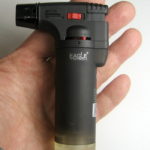 I bought a cheap butane torch on Ebay to keep at the space (yeah, in violation of the “no pressurized gasses” rule, but stashed away in my box). Worked fine, rarely used.
I bought a cheap butane torch on Ebay to keep at the space (yeah, in violation of the “no pressurized gasses” rule, but stashed away in my box). Worked fine, rarely used.
When I wanted to bend some laser cut acrylic to make cases for 485 net nodes, it worked fine – until it didn’t. It just wouldn’t stay lit. I brought it home, refilled it and brought it back to the space the next week, but it still wouldn’t light and wouldn’t even stay lit if lit from another flame (butane lighter in electronics lab).
Failing to try the obvious small screws, and thinking it was all but junk, I tried to unscrew the obvious metal tip housing. It turned, but didn’t feel like it was unscrewing. No more acrylic bending for you. Grumbling, I brought it back home.
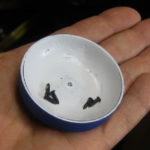 I finally removed the little screws, (seen here in my nice Bondo-filled plastic cap parts tray).
I finally removed the little screws, (seen here in my nice Bondo-filled plastic cap parts tray).
Kudos to the manufacturer for making all 5 screws the same size. 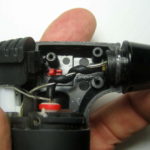 🙂 When I popped it open, I was met with this interesting view:
🙂 When I popped it open, I was met with this interesting view:
It wasn’t too embarrassingly long until I realized this was the result of trying to unscrew the tip. Not much gas gonna come out like that. Fortunately, nothing was damaged, and it was an 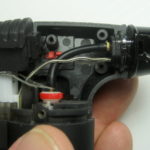 easy fix.
easy fix.
Side question: The insulated wire is clearly (ha!) for the ignition spark. But where’s the return path? Is the black tube conductive?
But it still didn’t light or stay lit. Butane torches and lighters are pretty similar, so after lots of YouTubes and nut-case lighter people forums, I learned:
- Many say you should vent it (hold with fill valve up, depress valve with small tool, let some gas out.) Recommendations vary from “bleed it empty every time before you refill” to “every several months”, to “when needed”.
- There are religious arguments about fuel, with comments running 20-1 in favor of triple- or quintuple distilled brands. Disbelievers point out the 5X stuff is really only distilled 3 times, with just filtration steps in between, so not really 5X. <rolls eyes> Ronson (what I have) is pretty universally put at the bottom of the list. And then the 5% guy pipes up with “I use nothing but Ronson, and haven’t had a problem in 10 years.” Hmm.
- LOTS of people complain about short lifespans of even name brand (Bernzomatic et al) torches. The ignition systems are the biggest complaint. My igniter still works fine – the torch just doesn’t work.
- One seller of torches (and 5X fuel!) started a video with half a dozen assorted torches customers had returned as not working. He claimed “There’s nothing wrong with any of these. They just used bad fuel!” Hmm.
Because mine would ‘pop’ frequently, but just never stay lit, as I thought about it, it started to feel like a fuel problem. If there were really some air in the tank, the mixture wouldn’t be right, and that might result in the behavior I was seeing. (OK, if the flame didn’t back up into the air-sullied tank and explode first. Which it hasn’t done, reflecting poorly on this hypothesis. Fortunately.) But the ‘purge’ idea resonated anyway.
Tried a couple of purge cycles – no change. At least that’s consistent with not exploding.
The nozzle is a venturi/reverse carburetor (airburetor?) sucking the air in. Might those passages be blocked? Using another suggestion from the forums, I blasted it with compressed air. No change.
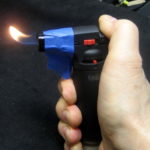 I’d seen demos of torches with mixture adjustments go to a soft yellow flame with the air turned off. Mine doesn’t have that, but what if I blocked the air inlets? With blue painter’s tape putting it on ‘full choke’, I got this surprising but unsurprising (!?) result:
I’d seen demos of torches with mixture adjustments go to a soft yellow flame with the air turned off. Mine doesn’t have that, but what if I blocked the air inlets? With blue painter’s tape putting it on ‘full choke’, I got this surprising but unsurprising (!?) result:
Slowly peeling the tape away gave a normal looking flame. More air, and it blew out. Hmm.
Playing with the red gas volume adjustment, it would close all the way off, and seemed closest to working with it on full. Is there some further hidden adjustment? Thinking 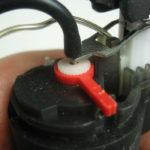 back on what I’d seen when it was open – was that red adjustment on a splined fitting? <opens it up again> Sure enough!
back on what I’d seen when it was open – was that red adjustment on a splined fitting? <opens it up again> Sure enough!
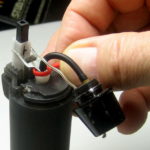 I set it to about mid way, lifted it off and set it back so the red lever was close to its lowest setting.
I set it to about mid way, lifted it off and set it back so the red lever was close to its lowest setting.
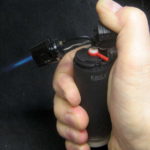 Moving it back up to full throttle, it lit!
Moving it back up to full throttle, it lit!
I moved it again to give myself a little more top end, put it back together, and it works again. That’s great. But why did it fail?
My best guess is there’s some crud (See? I told you that Ronson stuff was crap!) in the gas path and the valve needs to be open more than when new to get enough gas out. It could (well?) be that that’s what lots of short-lifespan people are seeing, but they don’t have a way to turn the gas up more. I’m not going to do a clean room teardown to check that out. It works again, so I’m done!
Maybe a takeaway is that a torch with more full-scale gas control (like a real needle valve) is more robust against a little crud in the line. (And might as well ask for air/mixture control, too.)
A couple weeks later
I came across a closeout display of obviously identical design torches for $2.69 each (regular $4.99). Only 2 left. Their cool feature was a bottle opener in the screw-on base (which I had no interest in). The clear blue one had the bottle opener (and visible fuel), but no gas came out. The clear  orange one didn’t have an opener (and thus a slightly less stable bottom), but lit.
orange one didn’t have an opener (and thus a slightly less stable bottom), but lit.
I expect 60% I could have fixed the blue one, but didn’t have a #0 Phillips with me (and was standing in the aisle at Menards). I took the orange one.
And a couple more weeks later…
11/30/19: The orange torch was an impulse purchase – I had no particular use in mind for it. (But it was such a deal!) It lived on the electronics bench near the good Portasol torch (with soldering attachment) which is the reason I didn’t need another.
While finally working on cleaning off the bench the other day (yay!), I came across some bulky PCBs I’d apparently saved to salvage some parts from. I almost just pitched them (in the electronics recycle), but saw the orange torch, thought it might work well, and gave it a try.
After I hit my stride, it worked about perfectly for the task, and I soon had a stack of clearly salvaged parts that might come in handy some day. I don’t do that very often, but I’ll try to remember that a small torch works well for it.
Spark return path
10/29/23 I’ve long suspected that the black gas tube was the electrical return path for the ignition piezo, and have finally proved it.
I found an old torch, opened it up, and pried the black tube off at the tank end. Measuring the resistance of the tube from end to end showed 600Ω. This isn’t just any rubber tube! That very unusually high conductivity is completely consistent with having it function as the spark return path.
With the hose so disconnected and held out of the way, I operated the spark generator several times, while looking carefully for a spark. There was no spark.
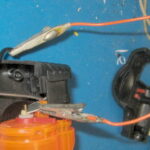 Then I connected the loose end of the hose – still held out of the way – to the metal end of the piezo generator that originally touched the tank end of the hose. And it gave sparks!
Then I connected the loose end of the hose – still held out of the way – to the metal end of the piezo generator that originally touched the tank end of the hose. And it gave sparks!
I take this as definitive evidence that the conductive black tube is indeed the return path in the spark circuit.
As for where to get conductive hose like that, a quick Google for ‘conductive rubber hose’ showed that conductive rubber really is a thing. Who knew?

We have the same question about the spark and return path. It has us scratching our heads for several months now. Did you ever figure out the return path for certain?
Thanks Shannon
I’m not sure how but some of them don’t need a return path. I’ve seen some that have a wire coming off the bottom of the igniter to the head and some that use the metal body of the torch. but some are plastic and simply have no return path. If you remove the igniter from the torch and use tape or something on the bottom of the igniter & click it the end of the wire will zap you too with no return path. I just know it doesn’t have one but if anyone can explain that it would be tight.
The problem is in the filter itself there’s a little metal filter with a screen in it If you pull that apart where the hose connects The little brass pc end pops out and there’s 2 screens in there wipe them off Don’t lose the two screens or the little o ring or you will be in trouble
Thanks, Jacki! I just took mine apart again a month ago and adjusted the throttle to give yet some more gas. A clogged screen is consistent with the behavior I’ve seen. I guess it’s also consistent with the folks that swear by the quintuple-distilled fuel. 🙂
I’m sort of invested in them now – just bought four more on ebay, so I’ll be dealing with them for a long time. I look forward to cleaning the screens the next time I take one apart!
Does any one know where to find a seller of the hose for touch lighters
Yes please I would also like to know where to get the hose line ???
Yes, where can I purchase and what size is the rubber hose
Take a 14 Guage wire and strip off the outer casing. Use the casing for a hose.
it doesn’t need a return pass because it is what is called the pieso electric effect. basically, there’s a small piece of mineral, usually quartz, in the bottom of the metal piece. There’s a steel rod attached to the top part that you squeeze in it clicks, and there’s a spring that puts tension, sort of like a window breaker. Anyway, when you squeeze it, it builds the pressure up and when it clicks that steel rod strikes the courts and it throws the spark and that’s what travels up the wire. So basically it’s mechanically done there is no electricity so it doesn’t need a return line because the electrons are only flowing one way.
Yes, it’s certainly a piezo-electric generator. But I don’t think either the ‘there is no electricity’ or the ‘electrons only go one way’ is correct. A return path is certainly needed. My best guess remains that the black tubing is sufficiently conductive to provide that path. If I have a dead torch, maybe I’ll do some experiments to verify that.
Jim
A return path isn’t required because the spark is just the voltage you generated (from the piezoelectric effect) discharging. There’s no continuous flow of current so there’s no need for the return path. The Piezoelectric effect is very unique, only quarts and ceramics I think have the properties. But if they’re struck and deformed in any way it creates voltage through the entire material then try to equalize (thus spark). It’s just a strong pulse of energy, and a return path would imply that that energy will continue to exist, within the quarts
I respectfully disagree.
Another method I’ve seen used for providing a return path for the elecrons is in piezo electric quartz ignited long candle/ BBQ lighters that actually have a gròund wire eading to th bac of the nozzle through the inside of the rubber fuel hose, instead of probably more expensive conductive rubber.
Hi my name is Brad I’ve worked on 100 plus torches and yes it has an electrical return path the black hose conducts electricity. You’ll know this using an ohms meter I’m still kinda puzzled to the current path my self but from my experience the top half the smaller end that fits into the larger end is usually where the problem exists if you look very closely you will see hair line cracks in the plastic that causes a no spark situation you can use the smaller end of another stricker to fix the problem
in my experience if torch burns constantly for about 30+ seconds and gets “hot” the red gas adjustment lever has to be adjusted to increase it, i usually max it shimmy it off n put it centre n test, sometimes it perfect other times another max it then shimmy it off n centering works….not sure why kinda feels more like a temperature issue somewhere only torch that could burn till the gas is empty n not need adjustment was a dremel